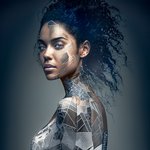





Not many academic panel discussions worm their way into your dreams.
Thursday afternoon at the MSU Museum, writing Professor Bill Hart-Davidson struggled to describe how new and powerful forms of artificial intelligence generate essays, poems and images that are impossible to distinguish from work done by humans.
He explained that the new generative models are trained on such vast amounts of data, and process that data across so many dimensions, that “it is not even possible to think about it in human terms.”
“We can’t even visualize or imagine the space that it’s working in,” he said.
Give the generative AI model DALLE-E2 a simple, brief text prompt like “five platypuses playing poker, in the style of Norman Rockwell” and you get a finished work of art that fits that description in less than half a minute. Ask ChatGPT if that platypus picture really is a work of art and you’ll get a cogent summary of the philosophical and aesthetic principles involved in roughly the same amount of time.
Generative AI — a type of artificial intelligence technology that can produce text, imagery, audio and synthetic data, among other content — has already created magazine covers, passed the bar exam and co-authored an article in a medical journal, and faster, more powerful models are on the way.
(This week’s cover of City Pulse was created by a generative AI model called DALL-E2 by entering the words “Modernistic painting of the Accident Fund building overlooking the Grand River in Lansing, MI.)
The rollout in late 2022 of Chat-GPT3 and other generative models put hopes and fears about AI at the forefront of public discourse, most of it running to extremes.
“Soon we will find ourselves living inside the hallucinations of non-human intelligence,” warned a March 24 guest essay in The New York Times by Yuval Harari, Tristan Harris and Aza Raskin. “By gaining mastery of language, A.I. is seizing the master key to civilization.”
Others downplayed the new AI models as the white-collar equivalent of a Roomba — “trivial” in comparison with the human mind, linguist Noam Chomsky and two colleagues wrote in the Times on March 8. “Such programs are stuck in a pre-human or nonhuman phase of cognitive evolution,” Chomsky and his colleagues pooh-poohed. “We can only laugh or cry at their popularity.”
The discussion at the MSU Museum Thursday mirrored the debate in society at large.
There were a few gasps in the audience at Thursday’s AI panel as Bill Hart-Davidson blandly declared that when a student hands in a written assignment, it can no longer be assumed that it is “their practice.”
But the problem is not new, he said. When pocket calculators became widely available in the 1970s, math teachers required students to show their work. He suggested that something similar will be needed in any classes that rely on written assignments.
“Show me how you got this result, talking through it,” Hart-Davidson said, acting out a one-on-one conference with a student. “‘You didn’t write this? What did the robot do there that you might do differently?’ Now we’re back in a better conversation about writing and thinking.”
The panel members agreed that transparency will be key, not just in the classroom, but in every corner of the creative sphere and the knowledge economy.
“We quickly need conventions of disclosure,” Hart-Davidson said. “We need ethical and clear ways of saying, ‘Here’s how I used AI. Here’s what it did and didn’t do.’”
“Some sort of digital watermarking would be important, definitely,” panelist Anjana Susarla agreed.
Susarla bears the 21st-century title of Professor of Responsible AI at MSU’s Eli Broad College of Business.
She expressed deep concern about the rush to bring generative AI to the market and, eventually, embed it into widely used platforms like Microsoft Excel and Gmail, before ethical guardrails and transparency rules are in place.
“I was more optimistic a year ago,” she said. “But since November, I’m more worried. The scale at which these things — these large language models are operating now, and the amount of data they’ve been trained on, makes me skeptical that we can reverse it.”A man in the audience asked if art created by AI will ever be truly indistinguishable from art created by humans. Panel moderator Mark Sullivan, a composer and photographer and director of the MSU Museum’s cutting-edge CoLab, answered quickly: “I already think we’re there.”
At a recent meeting of a photographers’ group Sullivan belongs to, one member revealed that all the black and white portraits he’d made in the previous two years, and the stories of the people in the portraits, were generated by AI.
“These were all high-level professional photographers,” Sullivan said. “None of them noticed until he said it.”
Sullivan suggested that a national governing body, such as the recording industry’s ASCAP or BMI, could be set up to oversee the distribution of royalties to creators whose works are filtered through AI to create new works.
Hart-Davidson was skeptical. He compared the training data fed to the AI model to dots or lines in a much bigger picture.
“If it were a song, any one text really contributes only one or two notes — not even a chord progression,” he said.
“It’s a nightmare for the legal world,” Sullivan agreed, not without relish. He appeared to be enjoying the current disruptive moment.
“A lot of graphic designers are simply adding this to their toolkit,” he said. “They can use it to generate drafts fast and then evaluate them.”
In the June 2022 issue of Cosmopolitan magazine, writer Gloria Liu described generative AI’s understanding of relationships as “keen and contextual.”
That month, Cosmo published what it heralded as the first AI-generated magazine cover, a low-slung image of a stylish woman astronaut making confident, fashion-runway strides along the purple sand ripples of an alien planet.
“Type ‘Darth Vader on a Cosmopolitan magazine cover’ and DALL-E doesn’t just cut and paste a photo of Darth,” Liu wrote. “It dresses him in a gown and gives him hot-pink lipstick.”
“Keen and contextual” as they are, generative AI models often replicate, or even magnify, the cultural biases that pervade the training texts and images.
Sullivan told the group Thursday that he gave the image generator Midjourney a simple prompt: “a person walks down the street.”
“After generating 20 or 30 persons, walking down the street, I’d be like, ‘Isn’t there a single person of color in this program?’” he said. “When I said, ‘an Indian woman,’ it gives me a woman in a headdress. What do I have to do to get someone from India?”
“On many of these AI platforms, if you prompt it to show a couple, it will invariably be white,” Susarla agreed. “Unless you prompt ‘poor,’ then it will invariably be people of color, because people of color are poor, right?”Susarla said the most interesting development in AI tech the previous week offered little comfort that ethical guardrails were forthcoming.
In March, Microsoft laid off its entire Ethics & Society department, gutting the division that was responsible for evaluating the risks of integrating OpenAI’s tech into its products.
The layoffs took place just when AI tech such was accelerating into new and uncharted waters. Susarla sharply questioned Microsoft’s rush to bring AI to the market.
“It not like we’re trying to cure cancer here, or do something to save the planet from imminent climate catastrophe,” she said. “Why wouldn’t they want the checks and balances you need to bring a car to the market? We have a National Highway Safety Commission that evaluates everything very carefully. We don’t have the equivalent of that in AI.”
Hart-Davidson responded to an audience question about Internet privacy as if the horse had left the barn long ago.
“I don’t like to be a technology fatalist,” he said. “But there is so much training data out there, that is not owned by us already, that is up to the discretion of companies like Google to just sell and re-use, that they don’t really need any more. Withholding your own information is like recycling one plastic bottle and stopping climate change.”
The MSU Museum’s “Prompt Response” exhibit is as simple as they come — a dark little room where one station is equipped with DALL-E2 and another with ChatGPT.
But the swift rollout of he exhibit and its largely virtual field of action reflect the sharp pivot in the museum’s mission.
A large wall screen projects generative AI images produced by students at home or in the classroom.
The user-created images are beamed, via Brightsign technology, to similar displays in several buildings across campus.
It usually takes many months, and sometimes years, to plan and develop an exhibit, but museum director Devon Akmon said last fall’s wave of powerful AI tech called for something quicker.
“Suddenly, boom! This generative AI was everywhere,” Akmon said.
In the spirit of recent exhibits on the surveillance state and climate change, Akmon saw a perfect opportunity to fulfill the museum’s mission to serve, not just as an exhibit space, but a hub for understanding and discussing critical emerging issues in science and technology.
The project focuses on the MSU community, but Akmon expects it to become “porous” and include greater Lansing.
“We understand that this is going to spread, and if someone submits some stuff, we’re going to be inclined to include it,” Akmon said.
The discussion isn’t limited to words and images. On Sunday (see box on P. 11), Sullivan will host a sonic art workshop where participants will mess around with generative AI models, like Riffusion and Mubert, that can dish up a mash-up of Mozart and Mos Def or anything else you ask it for.
Sullivan is not your stereotypical college professor. As a musician, photographer and director of CoLab, the MSU Museum’s collaborative research laboratory, he eats new tech for breakfast. When Akmon first got the idea to do an exhibit on generative AI, his first move was to say, “Mark, look into this.”
If this were a 1950s sci-fi movie, Sullivan would be the wide-eyed scientist who wants to communicate with the aliens instead of opening fire, or the prof who waits until the dean goes home to lock himself into the lab and activate the atomic ray or inject the growth serum.
He’s been working with various forms of AI for over 35 years, mostly in connection with generating sounds, but more recently in generating stunning images that extend his innovative work as a photographer.
“I never thought AI would come to desktops, much less editing and writing,” he said. “It’s gone way beyond anything I imagined possible 30 years ago, even in the crazy late-night symposiums after conferences where people really stretched out.”
Sullivan has his fingers crossed that MusicLM, Google’s new AI sound generator, will be available by Sunday’s workshop. He was already composing verbal prompts in his head.
“A huge piece of steel being torn in half, followed by 20 tons of concrete falling on the street in the city,” he said with glee. “Type in the prompt and it constructs a sound that fits. I want to try this!”
MusicLM isn’t available yet, but tech giants are tumbling over each other to roll out new AI models, and updated versions of old ones.
“Things are coming out every day,” Sullivan said. “I’m trying, but things are coming out so fast and furious I can’t keep up.”
From poker-playing platypuses to 20 tons of falling concrete, it’s no wonder my day at the museum got into my dreams. My neural network, like the processes generative AI use to produce text and images, is a black box to my conscious mind, but it spent the night working like mad.
In the part of the dream that I remember, I jumped off a half-scale, Detroit Zoo-sized train, tossing my bag off the side first, and found myself in Old Town. Was it the past or the future? There were cigar factories, a sawmill and horses clomping around, but computer stations and headsets were discreetly tucked into the alleyways.
People were square dancing in a beautiful hall decorated with bunting. A soothing Baptist hymn filled the air, but there were no choristers around. The music came from tiny speakers embedded in the ground. Suddenly, a man with a white shock of hair and intense eyes, who closely resembled Mark Sullivan, was standing next to me.
“I’m not who you think I am, but it doesn’t make any difference,” he said. He was smiling. The dream felt very real.
Support City Pulse - Donate Today!
Comments
No comments on this item Please log in to comment by clicking here